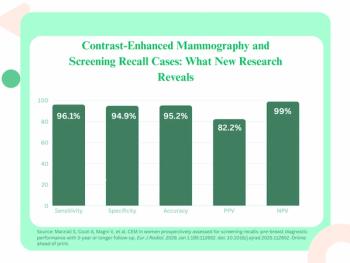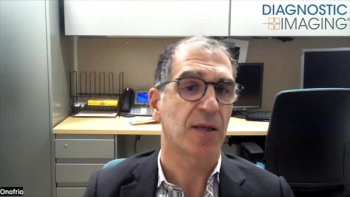
Risk-Based Approach Could Optimize Mammography During Crises
Focusing on high-to-very high risk patients could provide the greatest cancer detection rate with the fewest exams during times of reduced capacity.
During public health emergencies, such as a global health crisis, prioritizing mammograms for women who have the highest likelihood of developing breast cancer can lead to the greatest cancer detection rate when capacity and resources are low.
From the onset of the COVID-19 pandemic, breast imaging facilities put all services except the most critical cases on hold, and determining which women still needed to be brought in for mammograms was a puzzle. But, now, a multi-institutional team of researchers has created a risk-based approach that uses patient risk factors and clinical indications to triage women for mammography services during critical times.
The team, led by Diana L. Miglioretti, Ph.D., chief of biostatistics at the University of California-Davis School of Medicine, determined roughly 12 percent of mammograms account for more than half of breast cancers identified. They published their findings March 25 in JAMA Network Open.
Related Content:
“The approach we propose may provide a model for prioritizing use of screening, diagnostic, or other medical services for other types of conditions during periods of reduced capability or in resource-limited settings,” Miglioretti said, noting that the algorithm could also potentially be used to prioritize other studies, such as screenings for cervical and prostate cancer, low-dose CT for lung cancer, and colonoscopy.
While their results complement the American College of Radiology’s “Return of Mammo” toolkit, Miglioretti said, their recommendations differ from patient prioritization guidance released earlier in the pandemic by the Society of Breast Imaging (SBI). The SBI instructions give preference to women undergoing short interval follow-up exams rather than screening evaluations, but the organization did not specifically address how breast cancer risk factors should be considered or how personal breast cancer history should be addressed, the team said.
For their study, the team assessed self-reported and database-derived clinical indicators for screening, breast symptoms, personal and family breast cancer history, age, interval since last screening, breast density, and history of high-risk breast lesions. They used the data to categorize women into five groups from very high risk (>50 cancers detected per 1,000 mammograms) to very low (<5 cancers detected per 1,000 mammograms).
By examining results from 1,878,924 mammograms performed on 898,415 women enrolled in the Breast Cancer Surveillance Consortium at 92 facilities between 2014 and 2019, the team determined that more than half of cancers detected – 55 percent – are found in the 12 percent of mammograms that have a high-to-very high number of cancers (36.1-to-89.6 cancers per 1,000 mammograms). In fact, the 3.1 percent of mammograms classified as very high risk for cancer detection captured 25.3 percent of cancers.
Those scans evaluated breast lumps and abnormal mammograms in women of all ages with a breast cancer history, as well as non-lump breast symptoms in over age 60 with or without a previous history.
Overall, annual screening mammograms for women between ages 50 and 69 (44.2 percent of all evaluated mammograms) produced only 13.1 percent of detected cancers – just 3.8 cancers per 1,000 mammograms, the team said.
The team did notice increases in the CDR based on several factors. For instance, while the rate was 6.9 per 1,000 mammograms at first screening, it increased with greater screening interval time from 3.9 per 1,000 scans for annual screens to 8.1 per 1,000 if intervals were three or more years. Age was also a factor, growing from 2.8 per 1,000 scans among women ages 40-to-49 to 8.0 per 1,000 scans for women over age 70.
They also saw a greater CDR with increasing time between surveillance mammograms from 10.8 per 1,000 for one year to 36.8 for 1,000 for women who last had a mammogram three or more years ago. Interestingly, they noticed that mammograms performed less than a year apart, though, produced a 15.1 CDR. Age was also a factor with these mammograms, growing from 9.2 per 1,000 for women younger than 40 to 15.8 for women age 70 and above. Time from diagnosis made a difference, as well, with women diagnosed within five years experiencing a 7.7 per 1,000 CDR while women 10 or more years from diagnosis seeing 17.5.
Related Content:
Given these findings, the team determined that clinical indication, age, and time since diagnosis for women with a history of breast cancer were most strongly associated with CDR. For low and very low risk groups, the time interval since their last mammogram was important.
With this information, they designed two types of algorithms facilities can use and modify to fit their needs to triage mammograms – one to schedule high-to-very high CDR scans when operating at 12-percent capacity and one to schedule moderate-to-high CDR mammograms when at 20-percent capacity.
“Clinicians could use our results to counsel individuals about how urgently they should seek breast imaging based on their breast symptoms, breast cancer history, age, and time since last mammogram,” the team said. “We demonstrate that triaging individuals at highest risk of having cancer detected could result in detecting the most cancers while performing the fewest examinations compared with a non-risk-based approach.”
For example, they explained, a non-risk-based approach results in 11.5 cancers detected per 1,000 scans, but their risk-based approach that concentrates only on the 12.1 percent of high-to-very high-risk scans produced a 3-to-10-fold greater CDR – between 36 and 122 cancers per 1,000 studies.
But, implementing these algorithms will have its challenges, Miglioretti’s team acknowledged. As the pandemic continues and the number of cases wax and wane, imaging facilities could struggle with scheduling obstacles as they try to work through a backlog of appointments with reduced staff and less appointment availability. Modifications to electronic health records that typically include risk factor information could enable automatic prioritization, they said.
“As part of our ongoing project, we are developing scripts that schedulers can use to encourage individuals with the highest risk to receive care as soon as possible despite the pandemic, and to reassure individuals whose care may be deferred owing to their low risk,” they said.
Related Content:
However, other stumbling blocks to using a risk-based approach during a crisis exist, said Sarah M. Friedewald, M.D., vice chair of women’s imaging at Northwestern Medicine, and Dipti Gupta, M.D., a Northwestern Medicine diagnostic radiologist, in an accompanying editorial.
“In the context of an acute crisis when a rapid reduction in patient volume is needed, it often is impractical for clinicians to sift through patient records to capture the information needed to triage,” they said. “Furthermore, asking non-clinical schedulers to be adept at culling data at this level at the time the patient calls to make an appointment is unrealistic. Although a series of predetermined questions could be asked of the patient regarding their personal history and reason for examination to ease the burden on schedulers, this system is vulnerable to patients who provide inaccurate or incomplete information.”
Instead, it would be much easier for schedulers to make appointments by either screening and diagnostic indications, and electronic medical record systems can already automate such appointments, they said. Additionally, relying on a risk-based approach could lead to an underuse of facilities that only offer screening and surveillance exams and could, potentially, accommodate more patients.
“The CDRs in various clinical settings provide valuable data points that could be potentially helpful in further understanding patient risk of developing breast cancer. However, these data should be used with caution as the only barometer for whether a patient merits cancer screening during a period of rationing,” they said. “Finally, the practicality of this process during the COVID-19 pandemic and extrapolation to other emergent settings are less obvious.”
Still, Miglioretti’s team said, their algorithm could lead to better cancer detection and long-term benefits to healthcare overall.
“Using data-driven strategies to identify subgroups at highest risk of disease during times of limited capacity may lead to less downstream strain on an already taxed healthcare system,” they said. “When capacity is limited, healthcare systems must ensure that the patients with the highest risk receive care.”
For more coverage based on industry expert insights and research, subscribe to the Diagnostic Imaging e-Newsletter
Newsletter
Stay at the forefront of radiology with the Diagnostic Imaging newsletter, delivering the latest news, clinical insights, and imaging advancements for today’s radiologists.




























